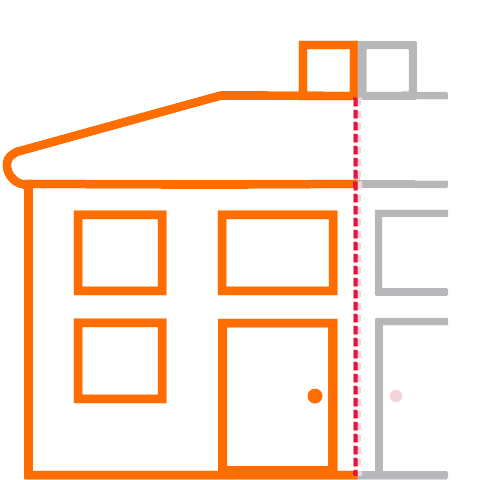You can successfully insulate your loft yourself if you have basic DIY skills and the space meets key requirements. The project requires proper safety equipment, including protective gloves, face masks, and safety goggles, along with essential tools like a utility knife and measuring tape. Before starting, you'll need to assess accessibility, check moisture levels, and guarantee adequate ventilation. Installation involves laying mineral wool rolls between joists, with a second perpendicular layer for complete coverage. While DIY installation can save money, complex issues like dampness or inadequate ventilation may require professional expertise. Understanding the complete process will help determine if this project suits your capabilities.
Understanding Basic Loft Requirements
Table of Contents
ToggleSuccess in loft insulation begins with evaluating your space's suitability for a DIY project. You'll need to assess three critical factors: accessibility, moisture levels, and joist configuration. If you can't easily move around your loft or spot signs of dampness, you'll want to address these issues before proceeding with insulation.
Your loft's ventilation system requires careful consideration, as proper airflow prevents moisture buildup that could compromise your insulation's effectiveness. You'll need to guarantee that existing vents remain unobstructed throughout the installation process.
When examining your joists, verify they're regularly spaced and in good condition, as they'll serve as your guide for laying mineral wool insulation rolls.
Before you begin the installation, you'll need to calculate the required insulation depth, which will affect both your energy savings and future loft functionality. Don't forget to plan for insulating water tanks and pipes, as these components become more vulnerable to freezing in an insulated space.
If your loft meets these basic requirements, you're well-positioned to proceed with a DIY installation that will enhance your home's energy efficiency.
Safety Precautions Before Starting
With your loft's basic requirements assessed, it's time to focus on protecting yourself during the installation process. You'll need to equip yourself with essential safety gear, including protective gloves, a face mask, and safety goggles to shield against insulation fibers and dust particles that can cause irritation to your skin, lungs, and eyes.
Before you begin handling any insulation materials, you must conduct a thorough inspection of your loft space. Check for signs of dampness or condensation, as these issues need addressing before installation, since insulation can trap moisture and lead to more serious problems.
You'll also need to examine the structural integrity of your loft and verify there aren't any exposed electrical wires that could pose safety hazards during installation.
Proper ventilation is essential, so you'll want to maintain adequate airflow throughout the loft space to prevent moisture accumulation.
Additionally, you should carefully review the manufacturer's guidelines for your chosen insulation material, as different types may require specific safety protocols. Understanding these requirements will help you avoid potential health risks and guarantee a successful installation process.
Essential Tools and Materials
Preparing for loft insulation requires gathering the right combination of tools and materials before you begin. You'll need a utility knife for precise cutting of insulation material, a measuring tape to guarantee accurate dimensions, and a staple gun to secure the insulation firmly between joists. These basic tools form the foundation of your DIY insulation project's success.
For the insulation itself, you'll want to select mineral wool rolls that match your loft's requirements, with thickness options ranging from 100mm to 270mm to accommodate various joist depths.
Don't forget to prioritize your safety equipment, including protective gloves, safety goggles, and a dust mask to shield yourself from irritating particles during the installation process.
You'll also need a sturdy ladder or scaffolding system to access higher areas safely while working in the loft space. If your project includes insulating water tanks and pipes, you should acquire additional materials such as pipe insulation sleeves or specialized wraps to prevent freezing during winter months.
This thorough collection of tools and materials will guarantee you're fully equipped to complete your loft insulation project effectively and safely.
Preparing Your Loft Space
Before gathering your tools and materials, a thorough inspection of your loft space will set the foundation for a smooth insulation project.
You'll need to evaluate the accessibility of your loft and check for any signs of damp or condensation that could compromise the effectiveness of your insulation work.
Next, you'll want to measure and assess the spacing between your loft joists, as consistent spacing will make it easier to install mineral wool insulation rolls effectively.
It's essential to remove all items from your loft space to create a safe working environment and guarantee you can move freely during the installation process.
While clearing the area, examine your loft's ventilation system carefully, noting the location of existing vents that must remain unobstructed.
If you notice insufficient ventilation, you'll need to take into account installing additional vents before proceeding with the insulation work.
If you're planning to use your loft for storage after insulation, you'll need to account for proper spacing above the insulation layer.
This means raising the storage platform to accommodate the required insulation depth while maintaining the structural integrity of your loft floor.
Step By Step Installation Guide
The installation process begins with laying your first mineral wool roll between the joists, starting from the point furthest from your loft hatch. As you work your way back toward the entrance, make sure you're pressing the insulation firmly against the joists without compressing it, maintaining consistent coverage throughout the space.
Once you've completed the first layer between joists, you'll need to add a second layer running perpendicular to the first. This cross-layering technique guarantees complete coverage of the joists themselves, which is vital for preventing thermal bridging.
For areas that aren't easily accessible with standard rolls, you'll want to use either blown insulation or rigid boards to achieve thorough coverage.
Don't forget to address your loft's infrastructure while you're working. You'll need to insulate any exposed pipes and water tanks, as the newly insulated space will be cooler than before.
Throughout the installation process, it's important to wear proper safety equipment, including protective gloves and a face mask, to shield yourself from potentially irritating fibers and dust.
Keep the insulation material dry and check regularly for any signs of dampness or condensation that could compromise its effectiveness.
Common DIY Installation Mistakes
While proper installation techniques set you up for success, many DIY enthusiasts make several common mistakes that can compromise their loft insulation project. The most critical error you'll want to avoid is failing to measure insulation thickness correctly, which can lead to inadequate coverage and result in considerable heat loss throughout your home.
You're likely to encounter problems if you don't pay attention to proper laying techniques. When you fail to install insulation between joists and at right angles, you'll create gaps that allow heat to escape.
Another serious mistake you'll want to avoid is proceeding with installation before addressing existing damp or condensation issues, as trapped moisture can lead to mold growth beneath the insulation. You shouldn't overlook proper ventilation either, since restricted airflow can create humidity problems that may damage your roof structure over time.
Additionally, if you forget to insulate water tanks and pipes in your loft, you're risking frozen pipes during winter months, which can result in expensive repairs and water damage. These oversights can considerably reduce the effectiveness of your insulation project and potentially create costly problems down the line.
When To Call Professionals
Safety-conscious homeowners should recognize when DIY insulation isn't the right choice. You'll need to contact professional installers when your loft shows signs of damp or condensation problems, as improper installation could worsen these issues and create long-term structural damage.
Professional expertise becomes particularly significant when you're dealing with complex insulation systems, especially those involving flat roofs or hard-to-reach areas where safety and proper installation techniques are paramount.
If you're planning to convert your loft into a living space, you'll want experienced contractors to handle the insulation of walls, ceilings, and dormer windows to guarantee compliance with building regulations and peak thermal performance.
You should also defer to professionals when your project requires additional ventilation considerations to prevent future moisture problems. This is especially important in areas prone to condensation or where airflow management is critical.
Additionally, if you're planning to use your loft for storage, professional installers can properly raise the insulation to the necessary depth while making sure your floor joists maintain their structural integrity, preventing potential safety hazards and maintaining the effectiveness of your insulation system.
Maintaining Your Loft Insulation
Once you've properly installed your loft insulation, whether by yourself or through professionals, maintaining it becomes your next important responsibility. Regular inspections will help guarantee your insulation continues to perform effectively and protect your home from heat loss.
You'll need to check periodically for signs of dampness or condensation, as these conditions can greatly reduce your insulation's effectiveness and potentially lead to more serious issues.
It's essential to maintain proper ventilation in your loft space, so don't block or seal off any existing vents, as adequate airflow helps prevent moisture accumulation and maintains insulation integrity.
If you've installed mineral wool insulation, you should monitor it regularly to confirm it hasn't shifted or settled unevenly.
When using your loft for storage, you'll need to avoid compressing the insulation material, as this can diminish its insulating properties.
Additionally, don't forget to insulate any exposed pipes and water tanks in your loft space, particularly before winter arrives. This step helps prevent freezing and maintains consistent temperatures throughout the insulated area, maximizing the overall effectiveness of your loft insulation system.
Cost Savings and Benefits
The financial rewards of proper loft insulation extend far beyond the initial investment. You'll notice significant reductions in your energy bills throughout the insulation's 40-year lifespan, making it a worthwhile long-term investment that typically pays for itself.
The thickness of your insulation, which can range from 0mm to 270mm across England, Scotland, and Wales, directly impacts your potential savings.
If you're considering the DIY route, you'll find it's particularly cost-effective when your loft is easily accessible and free from moisture issues. By installing the insulation yourself, you'll avoid professional installation fees while achieving comparable energy efficiency benefits.
However, you'll need to verify you're also insulating water tanks and pipes in your loft space, as this prevents costly freeze-related damages and maintains peak energy efficiency.
When planning your installation, consider that proper insulation creates cooler air in your loft space, which may result in cold draughts through the hatch. To maximize your savings and efficiency, you'll want to pay special attention to sealing the loft hatch and maintaining appropriate insulation depth throughout the space.





